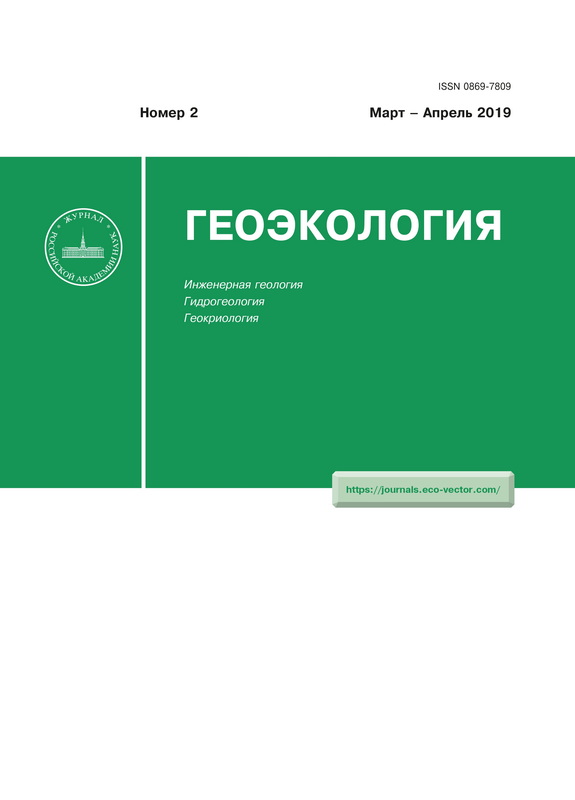Mechanism specifics of the landslide-hazardous massif limit state formation and landslide block displacement
- Authors: Postoev G.P.1
-
Affiliations:
- Sergeev Institute of Environmental Geoscience, Russian Academy of Sciences
- Issue: No 2 (2019)
- Pages: 13-20
- Section: NATURAL AND TECHNONATURAL PROCESSES
- URL: https://journals.eco-vector.com/0869-7809/article/view/12714
- DOI: https://doi.org/10.31857/S0869-78092019213-20
- ID: 12714
Cite item
Abstract
In the landslide cycle of deep block movement development, the landslide process starts with the separation of the new landslide block from the bedrock massif, and it ends with the block displacement until the steady landslide head is formed in the hotbed (on the landslide slope). The initial stressed state in the bedrock massif with horizontal earth surface (before the landslide block forms) is controlled by the Mohr-Coulomb criterion. The landslide hotbed forming as well as the sliding basis appearing cause the change in the initial stress state and the formation of horizontally oriented dissipative blocks-structures. The principal stresses are concentrated on the boundary surfaces of these structures (which are of a circular cylindrical shape). The limit state forms along these boundary surfaces of the appropriate block in the local massif zone on the contact with the landslide hotbed. The displacement occurs along the same surfaces, provided the equilibrium is disturbed. In forming the limit state of the head scarp massif, the adjacent part of the landslide massif (within the boundaries of the earlier separated landslide block) acts as an additional load (creates an active vertical pressure from the landslide mass weight) to the horizon of the landslide basis. The bedrock massif interacts with the slope at the stage of preparing block displacement. The block limit state is achieved in case the head scarp height reaches its critical value (the slope edge is higher than the landslide head). Under the soil masses weight in the new landslide block, separated from the bedrock massif, as it subsides, the soil crushes in a lower part of the block, which has lost its balance, in the slide basis zone. The paper considers the conditions of the new landslide block formation, the beginning of block displacement process, the mechanism of interaction between blocks, the bedrock massif and the landslide body, which consists of earlier displaced landslide blocks. The paper also provides the rationale for the soil strength changes in the process of displacement and its significance in the landslide cycle completing, with comparing the results of theoretical and experimental studies.
Full Text
About the authors
G. P. Postoev
Sergeev Institute of Environmental Geoscience, Russian Academy of Sciences
Author for correspondence.
Email: opolzen@geoenv.ru
Russian Federation, 13, str. 2, Ulanskii per., Moscow, 101000
References
- Goldshtein, M.N., Turovskaya, A.Ya. Razvitie opolznevykh smeshchenii v zapredel’nom sostoyanii. Inzhenerno-geologicheskie svoistva porod i protsessy v nikh [Landslide displacements development in the over-limit state. Engineering geological properties of soils and processes therein]. Trudy Mezhdunarodnogo Simpoziuma [Proc. Intern. Symposium]. Moscow, MGU Publ., issue 2, 1973, pp. 110-119. (in Russian)
- Emelyanova, E.P. Osnovnye zakonomernosti opolznevykh protsessov [Main regularities of landslide process]. Moscow, Nedra, 1972, 308 p. (in Russian)
- Ivanov, I.P. Inzhenerno-geologicheskie issledovaniya v gornom dele [Engineering and geological researches in mining]. Leningrad, Nedra, 1987, 255 p. (in Russian)
- Kropotkin, M.P. Priroda krupnykh opolznei Moskvy i Podmoskov’ya [The origin of large landslides in Moscow and Moscow region]. Inzhenernaya geologiya, no.1, 2016, pp. 4-14. (in Russian)
- Kyuntsel, V.V. Zakonomernosti opolznevogo protsessa na evropeiskoi chasti SSSR i ego regional’nyi prognoz [Regularities of the landslide process in the European part of the USSR and its regional forecast]. Moscow, Nedra, 1980, 213 p. (in Russian)
- Makeev, V.M., Grigorieva, S.V. Vliyanie neotektonicheskih dvizhenii na formirovanie opolznevogo sklona Vorob’evykh gor g. Moskvy. [Neotectonic movements impact on formation of landslide slope of Vorobievy Gory]. Inzhenernaya geologiya, 2016, no. 2, pp. 32-38. (in Russian)
- Naumenko, P.N. Usloviya formirovaniya i inzhenerno-geologicheskaya kharakteristika opolznei Chernomorskogo poberezh’ya Odessy. Opolzni Chernomorskogo poberezh’ya Ukrainy [Conditions of formation and geotechnical characteristics of landslides on the Black sea along the coast of Odessa. Landslides on the Black sea coast of Ukraine]. Moscow, Nedra, 1977, pp. 57–100. (in Russian)
- Paretskaya, M. N. Osobennosti inzhenerno-geologicheskikh svoistv yurskikh glin i opolzni Podmoskov’ya [Specifics of engineering geological properties of Jurassic clays and landslides of Moscow region]. Moscow, Trudy VSEGINGEO, issue 40, pp. 82-87. (in Russian)
- Postoev, G.P. Uravneniya sostoyaniya massiva pri formirovanii opolznei [Equations of a massif state during the landslide formation]. Inzhenernaya geologiya, 2010, no. 4, pp. 48-53. (in Russian)
- Postoev, G.P. Predel’noe sostoyanie i deformatsii gruntov v massive (opolzni, karstovye provaly, osadki gruntovykh osnovanii. [Limit state and soil deformations in a massif (landslides, karst failures, ground settlings)]. Мoscow, St. Petersburg, Nestor-Istoriya Publ., 2013, 100 p. (in Russian)
- Postoev, G. P. Dissipativnye struktury v gruntovom massive na primere formirovaniya glubokikh opolznei [Dissipative structures in a soil massif by the example of deep landslides formation]. Inzhenernaya geologiya, 2018, vol. XIII, no. 3., pp. 54-61. (in Russian)
- Prigogine, I., Stengers, I. Poryadok iz khaosa [Order out of chaos]. Moscow, Editorial URSS, 2003. p. 312. (in Russian)
- Tikhvinsky, I.O. Otsenka i prognoz ustoichivosti opolznevykh sklonov [Evaluation and prediction of stability of landslide slopes]. Moscow, Nauka , 1988, 144 p. (in Russian)
- Tikhonov, A.V. Nauchno-metodicheskie osnovy izucheniya glubokikh opolznei g. Moskvy s primeneniem vysokotochnykh metodov [Scientific methodological foundations of studying deep landslides of Moscow with the application of precision methods]. Extended abstract of Cand. Sci. (Geol.-Min.) dissertation, Moscow, RGGU, 2011, 23 p. (in Russian)
- Turovskaya, A.Ya. Zakonomernosti razvitiya opolznevykh protsessov v zavisimosti ot prochnostnykh i deformatsionnykh osobennostei glinistykh gruntov [Regularities of development of landslide processes depending on strength and deformation characteristics of clayey soils]. Extended abstract of Doctoral Sci. (Geol.-Min.) dissertation, Moscow, MGU Publ., 1979, 39 p. (in Russian)
Supplementary files














